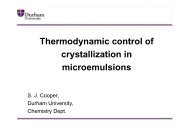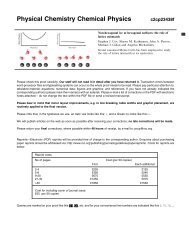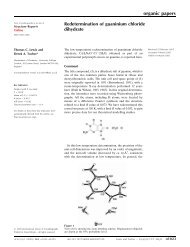ADVANCED USERS DMACRYS & NEIGHCRYS manual Manual ...
ADVANCED USERS DMACRYS & NEIGHCRYS manual Manual ...
ADVANCED USERS DMACRYS & NEIGHCRYS manual Manual ...
You also want an ePaper? Increase the reach of your titles
YUMPU automatically turns print PDFs into web optimized ePapers that Google loves.
Printed output<br />
Contributions to inter-molecular electrostatics<br />
(eV per unit cell [kJ/mol])<br />
The intermolecular electrostatic energies are written out. The charge charge, charge dipole and dipole dipole<br />
energies are calculated by an Ewald sum and are not written out here.<br />
Number of atom pairs calculated =<br />
The number of intermolecular interactions is written out. This is written out again at the end of the<br />
calculation and should be the same. If the unit cell relaxes by a large amount, this may move the distance<br />
between two molecule centres of mass across the cutoff boundary, in which case restarting the job with the<br />
relaxed molecule positions will result in a slightly different energy.<br />
Example output<br />
Contributions to inter-molecular electrostatics<br />
(eV per unit cell [kJ/mol])<br />
Z = 8<br />
CHAR-CHAR 0.0000 ( 0.0000 )<br />
CHAR-DIPL 0.0000 ( 0.0000 )<br />
DIPL-DIPL 0.0000 ( 0.0000 )<br />
QUAD-CHAR -0.4849 ( -5.8485 )<br />
QUAD-DIPL -0.2427 ( -2.9272 )<br />
OCTO-CHAR -0.0984 ( -1.1869 )<br />
QUAD-QUAD 0.0838 ( 1.0109 )<br />
OCTO-DIPL -0.0073 ( -0.0875 )<br />
HEXA-CHAR -0.0038 ( -0.0455 )<br />
0.0000 ( 0.0000 )<br />
Number of atom pairs calculated = 60612<br />
Printed output<br />
Centralisation of forces (global axes)<br />
and torques (global axes) for molecule:<br />
molecule<br />
Basis No. Species force (eV per Angstrom)<br />
x y z magnitude<br />
MAPX(J) ITYPL(IABS(LBAS(MAPX(J)))) (G1(JBASE+JJ)*EVPERA,JJ=1,3) GSIZE*EVPERA<br />
Central force GSTIFF((I-1)*3+JJ)*EVPERA,JJ=1,3 GSIZE*EVPERA<br />
Central torque GSTIFF(ITBASE+JJJ)*EVPERT,JJJ=1,3 GSIZE*EVPERT<br />
(eV per radian) [ GLOCAL(JJJ)*EVPERT,JJJ=1,3 ]<br />
The force vector together with the total force on each atom in each molecule are written out. This is<br />
followed by the total force on the molecule centre of mass and the torque on the molecule. As a consistency<br />
check on data input, the forces and torques on symmetry equivalent molecules should be of the same<br />
magnitude, but the sign depends on the symmetry relation between the molecules.<br />
Example output<br />
Centralisation of forces (global axes)<br />
and torques (global axes) for molecule: 1<br />
Basis No. Species force (eV per Angstrom)<br />
x y z magnitude<br />
1 C_F1_1____ -0.25612315E-01 -0.27546175E-02 -0.26987839E-02 0.25901004E-01<br />
9 C_F1_2____ -0.25861808E-01 -0.17797409E-01 -0.37804572E-01 0.49140274E-01<br />
<br />
Central force 0.24075885E-03 -0.85637891E-03 -0.10741764E-02 0.13947059E-02<br />
Central torque -0.17519048E-02 -0.44469848E-03 -0.27510559E-03 0.18282806E-02<br />
(eV per radian) [ -0.17964514E-02 0.79960003E-04 0.33011959E-03 ]<br />
Printed output<br />
Strain derivatives for matrix deformation of form<br />
The strain derivatives (stresses) on the unit cell are written out.<br />
Example output<br />
Strain derivatives for matrix deformation of form:<br />
/ |<br />
| E 1/2 E 1/2 E |<br />
| 1 6 5 |<br />
30







